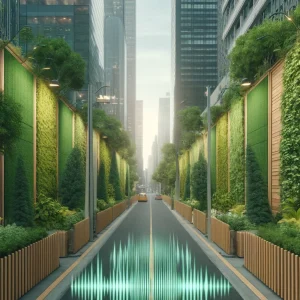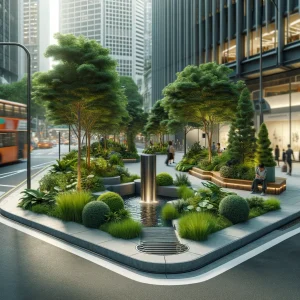In the bustling heart of our cities, where the symphony of urban life often escalates into a cacophony, finding tranquillity can seem like a quest for the holy grail. However, urban dwellers can reclaim their acoustic environment through innovative noise-reducing landscaping techniques and technologies. This blog explores how integrating specific plants, barriers, and groundbreaking materials can transform noisy neighbourhoods into serene sanctuaries.

Noise-Reducing Plants and Barriers
Plants are aesthetically pleasing and naturally adept at combating noise pollution. Dense hedges, for example, can effectively reduce noise as their thick, bushy leaves and branches create a soft barrier against sound waves. Cities like New York have used rooftop gardens and vertical green walls to add quiet layers to dense urban settings. These green installations absorb sound and add a splash of nature to the concrete jungle.
Acoustic fences, another critical tool in the noise reduction toolkit, are specifically designed to deflect or absorb sound waves. Materials used in these fences can range from wood and metal to specially designed acoustic panels that provide both functionality and visual appeal. These barriers are particularly effective along roadsides or residential areas adjacent to bustling streets.

Technological Innovations
Moving beyond natural solutions, technological advancements such as eco-baffles and sound-absorbing pavements are setting new standards in urban noise control. Berlin has pioneered eco-baffles—modular panels that can be integrated into urban landscapes to scatter sound waves. Similarly, sound-absorbing pavements, made from porous materials, decrease surface noise from traffic and enhance pedestrian comfort.
Benefits Beyond Silence
The benefits of reducing urban noise extend far beyond mere silence. Studies have shown lower noise levels can significantly enhance psychological well-being and increase property values. In quiet neighbourhoods, residents report higher satisfaction and reduced stress levels, leading to a more vibrant and engaged community.

Practical Implementation Tips
Consider starting small for those looking to implement noise-reducing features in their own communities. Planting shrubs and trees along property lines can gradually build a natural sound barrier. For immediate results, installing prefabricated acoustic panels around noisy areas can provide quick relief. Engaging with local urban planning initiatives can also scale these solutions to benefit the entire community.
As urban areas continue to grow, noise pollution will only escalate. However, with the strategic use of landscaping techniques and innovative technologies, we can create quieter, more enjoyable urban environments. Whether through the rustle of leaves in a lush garden or the silent absorption by high-tech materials, the path to a quieter cityscape is both viable and rewarding.
